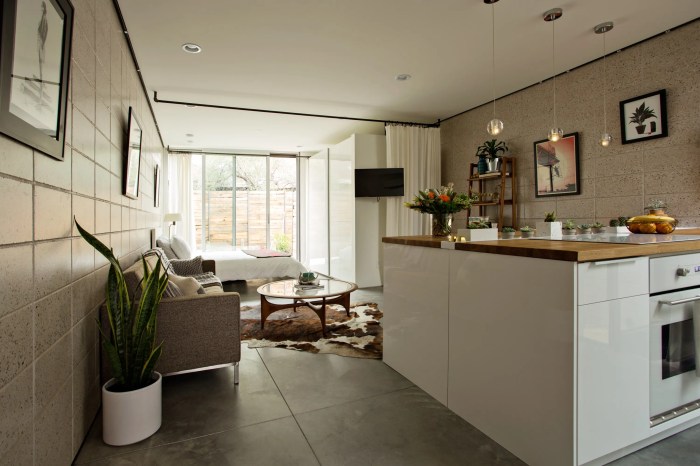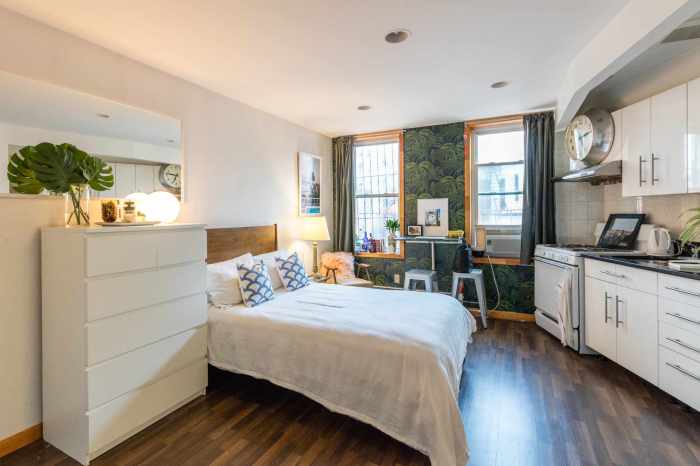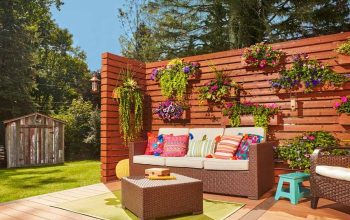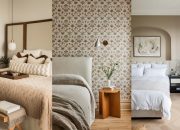Color Schemes and Wall Decor for Studio Flats: Studio Flat Decor Ideas

Studio flat decor ideas – Creating a visually appealing and functional studio apartment relies heavily on thoughtful color choices and strategic wall decor. The limited space necessitates clever design solutions to maximize the sense of openness and create distinct zones for different activities. By carefully selecting a color palette and incorporating appropriate wall art, you can transform a small space into a comfortable and stylish home.
Impact of Color Palettes on Perceived Space
Light and airy color palettes significantly impact the perceived size of a studio apartment. Cool colors such as blues, greens, and light grays tend to recede visually, making a room feel larger than it is. Conversely, warm colors like reds, oranges, and yellows advance visually, potentially making a small space feel cramped. Using light, neutral shades on the walls, such as soft whites or pale greys, is generally recommended for maximizing the sense of space in a studio apartment.
Adding pops of brighter color through accessories or smaller furniture pieces can then introduce personality without overwhelming the room. For instance, a pale grey wall could be complemented by vibrant teal throw pillows and a mustard yellow rug.
Studio flat decor necessitates creative space-saving solutions. To maximize the cozy feel, consider incorporating elements of nature, much like the relaxed vibe achieved in boho bedroom decor ideas , which often feature natural textures and earthy tones. Translating this aesthetic to a studio flat might involve using woven baskets for storage or incorporating macrame wall hangings to add visual interest without cluttering the space.
Using Color to Define Zones
Color is a powerful tool for visually separating different areas within an open-plan studio. Different color schemes can subtly delineate zones for sleeping, working, and relaxing. For example, a calming blue-green palette in the sleeping area can contrast with a more energizing yellow-toned workspace. This differentiation can be achieved using paint, rugs, or even strategically placed textiles. A darker, more saturated color can be used sparingly as an accent wall behind a bed or desk, creating a focal point without overpowering the overall space.
Suitable Wall Decor for Small Spaces
Wall decor in a studio apartment should be carefully curated to avoid visual clutter. Large, bold pieces can overwhelm a small space, while numerous small items can create a chaotic feel. Instead, consider a single statement piece of art, such as a large-scale photograph or a minimalist abstract painting. Mirrors can also be highly effective in small spaces, visually expanding the room and reflecting light.
A gallery wall of smaller, framed prints can work well if kept cohesive in terms of color and style, avoiding a cluttered appearance. Consider using shelves to display a few carefully chosen decorative objects, rather than covering the walls with numerous items.
Example Color Scheme for a Studio Flat
A suggested color scheme for a studio apartment incorporates a base of soft, neutral colors. The walls could be painted a pale gray, providing a clean and calming backdrop. Accent colors could include a warm, muted terracotta for textiles and accessories, and a deep teal for smaller details like throw pillows or a desk lamp. This combination creates a sense of warmth and sophistication without feeling overwhelming in a small space.
The terracotta brings in a touch of earthiness, while the teal provides a refreshing contrast, creating a balanced and visually appealing environment. The neutral gray provides a perfect canvas for these bolder colors to stand out.
Examples of Effective Color and Wall Art Use
Imagine a studio apartment with pale blue walls. A large, framed botanical print above the bed adds a touch of nature and calmness. The blue of the walls and the green tones in the print create a cohesive and tranquil atmosphere. In another example, imagine a small studio apartment with white walls and a single, large-scale abstract painting in shades of orange and yellow above a simple sofa.
This adds a vibrant pop of color without making the space feel crowded. The white walls create a clean backdrop that makes the art piece stand out. In a third example, a studio apartment with a neutral beige background utilizes a gallery wall featuring black and white photographs in consistent, simple frames, creating a cohesive and sophisticated feel without overwhelming the small space.
Lighting Solutions for Studio Flats

Effective lighting is crucial in a studio apartment, as it significantly impacts the overall ambiance and functionality of the space. Properly implemented lighting can enhance the feeling of spaciousness, highlight architectural details, and create distinct zones for different activities. This section explores various lighting solutions ideal for optimizing a studio apartment’s atmosphere and practicality.
Studio apartments often present a unique challenge in lighting design due to their open-plan nature. The goal is to create a versatile lighting scheme that caters to various needs throughout the day, from bright illumination for tasks to softer, warmer light for relaxation. This involves strategically combining different types of lighting to achieve a balanced and functional environment.
Types of Lighting for Studio Apartments
Studio apartments benefit from a layered lighting approach incorporating ambient, task, and accent lighting. Ambient lighting provides overall illumination, task lighting focuses light on specific areas for work or hobbies, and accent lighting highlights architectural features or artwork. For example, a central ceiling fixture might serve as ambient lighting, while a desk lamp provides task lighting, and strategically placed spotlights illuminate a piece of artwork.
This layered approach avoids harsh shadows and creates a more visually appealing and functional space.
Using Lighting to Enhance Ambiance and Architectural Features
Strategic lighting can dramatically alter the feel of a studio apartment. Warm-toned light bulbs, such as those with a color temperature of 2700K, create a cozy and inviting atmosphere, ideal for evenings. In contrast, cooler-toned bulbs (around 5000K) are better suited for tasks requiring more focus, such as working or reading. Using dimmer switches allows for adjustable brightness, further enhancing control over the mood and functionality of the space.
Highlighting architectural features, such as exposed brick or high ceilings, with accent lighting can add depth and visual interest. For instance, recessed spotlights directed at a textured wall or a unique architectural detail can draw the eye and enhance the space’s aesthetic appeal.
A Sample Lighting Plan for a Studio Apartment, Studio flat decor ideas
Imagine a 400 square foot studio apartment. A central recessed lighting fixture with dimmable LED bulbs would provide ambient lighting throughout the space. A floor lamp with a flexible neck positioned near a reading chair would offer task lighting for comfortable reading. Track lighting installed above the kitchen counter would provide focused task lighting for food preparation.
Finally, small spotlights could be used to highlight artwork or a decorative shelf. This combination of ambient, task, and accent lighting creates a functional and visually appealing space that caters to various activities.
Natural Light Versus Artificial Light
Natural light is highly beneficial in a studio apartment, providing a sense of spaciousness and improving mood. Maximizing natural light through sheer curtains or blinds instead of heavy drapes allows for ample daylight while maintaining privacy. However, reliance solely on natural light is impractical, especially during evening hours or on cloudy days. Artificial lighting becomes essential for evening activities and to supplement natural light during less sunny periods.
A well-balanced approach incorporating both natural and artificial light sources ensures a bright and inviting space throughout the day.
Energy-Efficient Lighting Options
Choosing energy-efficient lighting is both environmentally responsible and cost-effective.
The following are some energy-efficient options:
- LED Bulbs: LEDs offer long lifespans, low energy consumption, and a wide range of color temperatures.
- Smart Bulbs: Smart bulbs allow for remote control of lighting, enabling scheduling and customization of brightness and color.
- Solar-Powered Lights: For supplementary lighting, solar-powered lights can be a sustainable and cost-effective option, especially for balconies or outdoor spaces.
Furniture Selection and Arrangement for Studio Flats

Maximizing space and functionality is paramount when furnishing a studio apartment. Careful consideration of furniture choices and their placement is key to creating a comfortable and aesthetically pleasing living space. The right furniture can transform a small room from cramped to surprisingly spacious.
Choosing the right furniture for a studio apartment involves balancing practicality with style. Prioritizing multi-functional pieces and employing smart arrangement strategies are crucial for maximizing the limited space available. The goal is to create distinct zones within the open-plan layout, while maintaining a sense of flow and visual appeal.
Essential Furniture for Studio Apartments
Selecting essential furniture should focus on pieces that serve multiple purposes and contribute to a cohesive design. Avoid unnecessary clutter by prioritizing functionality and versatility.
- A sofa bed: This single piece provides both seating and sleeping space, maximizing functionality in a limited area.
- A coffee table with storage: This offers a surface for drinks and snacks, while also providing hidden storage for clutter.
- A compact dining table: A small, foldable or wall-mounted table can serve as both a dining and work surface.
- Multi-functional shelving unit: This provides storage for books, clothes, and other items, while also serving as a room divider.
- A wardrobe or closet system: Efficient storage is vital in a studio; consider built-in wardrobes or space-saving closet organizers.
Optimizing Furniture Arrangement for Flow and Distinct Areas
Strategic furniture placement is crucial for creating distinct zones within an open-plan studio. The goal is to delineate living, sleeping, and working areas without creating physical barriers.
For example, a sofa bed positioned against one wall can define the sleeping area, while a small dining table placed near a window can create a separate dining zone. A shelving unit can act as a visual divider between the sleeping and living areas, adding a sense of separation without compromising the open feel of the space. The key is to create visual boundaries through furniture placement and strategic use of rugs and lighting.
Suitable Furniture Styles for Small Spaces
Certain furniture styles are better suited for small spaces than others. Choosing the right style can significantly impact the perceived size and functionality of your studio.
- Minimalist furniture: Clean lines, simple designs, and neutral colors create a sense of spaciousness and calm.
- Multi-functional furniture: Pieces that serve multiple purposes, such as sofa beds, ottomans with storage, and convertible dining tables, are ideal for maximizing space.
- Lightweight furniture: Avoid bulky, heavy furniture that can make a small space feel cramped. Opt for lighter materials such as wood, metal, or acrylic.
- Compact furniture: Choose furniture with smaller footprints to maximize floor space. Look for slim sofas, narrow tables, and space-saving storage solutions.
Choosing Furniture that Complements the Overall Design Scheme
Furniture should harmonize with the overall design scheme of the studio apartment, creating a cohesive and aesthetically pleasing environment. Consider the color scheme, wall decor, and lighting when selecting furniture.
For example, if the studio has a minimalist design with neutral colors, furniture with clean lines and simple designs in muted tones would be a good choice. If the studio has a more bohemian style, furniture with warmer colors, natural materials, and intricate designs would complement the overall aesthetic. The key is to maintain consistency and create a visually appealing space.
Visual Representation of a Well-Furnished Studio Apartment
Imagine a studio apartment with a neutral color palette. A light grey sofa bed is positioned against one wall, acting as the focal point of the sleeping area. A small, round, white coffee table with storage sits in front of the sofa. A multi-functional shelving unit, painted a soft beige, is placed perpendicular to the sofa, separating the sleeping area from the living area without completely closing it off.
A compact, foldable dining table and two minimalist chairs are tucked away near a window, creating a small but functional dining area. A large, floor-length mirror is positioned strategically to maximize the feeling of space. The overall style is minimalist, with clean lines and a light, airy feel. Soft, natural light streams through the window, enhancing the sense of openness and calm.
Essential Questionnaire
What is the best way to deal with limited closet space in a studio?
Maximize vertical space with tall shelving units, utilize under-bed storage, and consider using over-the-door organizers for shoes and accessories. Investing in slimline hangers and vacuum-sealed storage bags can also significantly increase storage capacity.
How can I make my studio apartment feel warmer and more inviting?
Incorporate warm lighting (think warm white LEDs or soft incandescent bulbs), use textured textiles like rugs and throws, and add plants to bring life and warmth into the space. Warm-toned paint colors and cozy furniture also contribute to a more inviting atmosphere.
What are some affordable ways to add personality to my studio?
Affordable ways to personalize your studio include using thrifted or repurposed items, creating DIY artwork, using inexpensive textiles like throw pillows and blankets, and adding personal collections on shelves or in shadow boxes.








